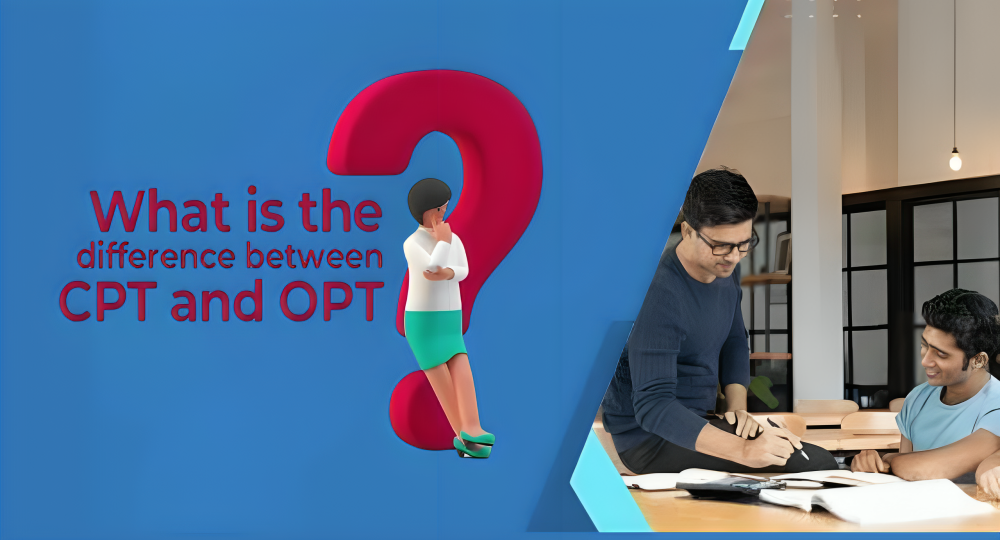
What is CPT?
If you’re an international student in the USA, you’ve probably heard the acronyms CPT and OPT thrown around quite a bit. But what do they really mean? More importantly, how do they differ, and which one should you choose? Let’s dive into the world of Curricular Practical Training (CPT) and Optional Practical Training (OPT) to uncover their secrets and help you navigate your way through your academic and professional journey in the USA.
Curricular Practical Training, or CPT, is a type of work authorization that allows international students on F-1 visas to gain practical experience in their field of study while they are still enrolled in their academic program. Think of it as an internship or practicum that’s directly tied to your coursework.
Eligibility Criteria
To be eligible for CPT, you need to:
- Have been lawfully enrolled on a full-time basis for one academic year.
- Have a job offer that’s directly related to your major.
- Get approval from your school’s International Student Office.
Types of CPT
Part-time CPT: You can work up to 20 hours per week while school is in session. This is a great option if you want to gain experience without overwhelming your academic schedule.
Full-time CPT: During breaks or if your program requires it, you can work more than 20 hours per week. However, be mindful—if you use 12 months of full-time CPT, you may not be eligible for OPT.
Application Process
Applying for CPT involves several steps:
- Obtain a job offer.
- Get your academic advisor’s recommendation.
- Submit the required forms to your International Student Office.
- Receive a new I-20 form with CPT authorization.
Check: Top 3 Ways Study Abroad In USA Helps To Build A Global Career
What is OPT?
Optional Practical Training, or OPT, allows F-1 students to work in their field of study for up to 12 months (or more with a STEM extension) after completing their degree. It’s designed to give you hands-on work experience that complements your academic achievements.
Eligibility Criteria
To be eligible for OPT, you must:
- Have been enrolled in an academic program for at least one full academic year.
- Be in valid F-1 status.
- Apply up to 90 days before completing your degree or within 60 days after.
Types of OPT
Pre-Completion OPT: Work part-time while you are still studying. This option is less common because it eats into your post-completion OPT time.
Post-Completion OPT: Work full-time after you’ve graduated. This is the most popular option, giving you a full 12 months to gain experience.
STEM OPT Extension: If you have a degree in a STEM field, you can apply for a 24-month extension, giving you up to 36 months of OPT.
Application Process
The OPT application process includes:
- Submitting Form I-765 to USCIS.
- Paying the application fee.
- Waiting for your Employment Authorization Document (EAD), which can take up to 3 months.
Differences Between CPT and OPT in the USA
The primary difference between CPT and OPT lies in the timing of the work authorization for F-1 visa holders. CPT can only be utilized before graduation, whereas OPT can be used both before and after graduation. Another key distinction is that CPT requires the work to be directly related to the student’s degree, while OPT does not have this requirement. Here are more key differences between CPT and OPT that students should be aware of:
CPT (Curricular Practical Training) vs. OPT (Optional Practical Training)
| Aspect | CPT | OPT |
|---|---|---|
| Eligibility | For F-1 students to gain practical experience related to their study area before graduation. | For F-1 students to gain practical experience before or after graduation. |
| Full Form | Curricular Practical Training | Optional Practical Training |
| Relation to Degree | Part of the student’s degree program | Not part of the degree program |
| Authorization | Requires consent from ISS (International Social Service) and the academic department | Requires permission from USCIS (US Government) |
| Duration | Up to 12 months | 12 months, extendable up to 24 months depending on the study program |
| Work Authorization Document | Not required | Requires an Employment Authorization Document (EAD) from USCIS |
| Working Hours | Part-time (20 hours/week) during the academic year, full-time (40 hours/week) during summer | Full-time after graduation |
| Application Fee | No fee for application | $410 payable to USCIS |
| Employer Restrictions | Must work with employers listed on Form I-20 and SEVIS | Can work with any employer across the USA |
These differences highlight the varying requirements and benefits of CPT and OPT for international students in the USA.
Read More: Insider Advice Ace USA F1 Visa Interview
CPT and OPT Visa Rules
CPT Visa Rules
- Semester-Based Authorization: CPT is authorized on a semester basis—fall, spring, or summer.
- Employer-Specific: Students can only work for employers listed on Form I-20 and SEVIS.
- Processing Time: ISSS typically processes CPT within 5-7 business days.
- Authorization: ISSS issues a Form I-20 with CPT recommendation to authorize CPT.
OPT Visa Rules
- Work Permit Duration: OPT provides a one-year work permit allowing students to find a job within 90 days after graduation.
- Non-Semester Specific: OPT is not tied to specific semesters.
- Types of OPT: Pre-completion OPT can be part-time or full-time; post-completion OPT is generally for full-time employment.
- Processing Time: OPT processing takes 1-3 months.
- Application Fee: There is a $410 application fee payable to USCIS for OPT.
These visa rules provide crucial information for international students to navigate the CPT and OPT programs while studying abroad and working in the USA.
How to Choose Between CPT and OPT
Career Goals and Field of Study
Consider your long-term career goals. If immediate work experience relevant to your coursework will help you, CPT might be the way to go. If you need more extensive work experience post-graduation, OPT could be more beneficial.
Timing of Work Experience
Think about when you need the work experience. If you want to work during your studies, CPT is suitable. If you prefer to start working after graduation, OPT is the better option.
Academic Schedule and Graduation Plans
CPT works well if your program includes internships as part of the curriculum. OPT is more flexible in terms of timing and can be used to bridge the gap between graduation and starting your career.
Long-term Visa Considerations
Using OPT after graduation can sometimes provide a smoother transition to an H1B visa, as you gain relevant work experience. Consider how each option fits into your broader immigration plans.
Advantages of CPT and OPT
| Aspect | CPT (Curricular Practical Training) | OPT (Optional Practical Training) |
|---|---|---|
| Skills Development & Experience in Real World | Focuses on providing practical experience and training students to apply theoretical knowledge in real-world scenarios. | Enables students to gain required practical work experience in their field of study after graduation. |
| Career Development & Exploration | Allows students to explore different career paths and fields, helping them identify their strengths and interests for informed career decisions. | Provides an opportunity to work in the US post-graduation, enhancing their career prospects and making them stand out to potential employers. |
| Cultural and Global Exposure | Offers international students exposure to global opportunities, new cultures, and professional environments, contributing to personal and professional growth. | Extends students’ stay in the US for 12 to 36 months, allowing them to gain valuable work experience and explore different career paths. |
| Networking Prospects | Helps students build connections and professional networks within their industry of interest, aiding in securing future job opportunities. | Provides opportunities to build professional networks and potentially transition to an H-1B visa through employer sponsorship. |
Conclusion
Choosing between CPT and OPT depends on your individual goals and circumstances. Both options provide valuable opportunities to gain practical experience in your field of study, helping you to build a strong foundation for your future career. By understanding the differences and carefully planning your path, you can make the most of your time as an international student in the USA.
For personalized guidance on selecting the right path, feel free to get in touch with us, study abroad consultancy, and avail of our wide range of services for students on destinations like study in USA, study in Australia, study in Singapore, study in Switzerland, study in New Zealand, study in Germany, study in UK, and many other countries.
FAQs
1.What is the main difference between CPT and OPT?
CPT is for practical training during your studies and requires a job offer related to your major, while OPT is for post-graduation work experience and doesn’t require a job offer at the time of application.
2.Can I use both CPT and OPT during my studies?
Yes, you can use both, but extensive use of full-time CPT can affect your eligibility for OPT.
3.How long does it take to get OPT approval?
OPT approval can take up to 3 months, so it’s important to apply early.
4.What happens if I don’t find a job during my OPT period?
If you don’t find a job during your OPT period, you may need to consider other visa options or return to your home country. Staying informed and proactive in your job search is crucial.



